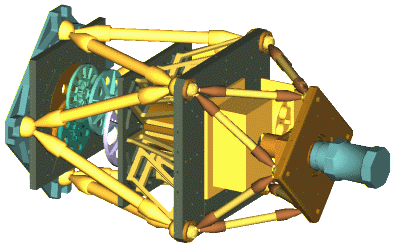
CONTENTS |
||
A brief history
|
Overview
|
Observing Modes |

CONTENTS |
||
A brief history
|
Overview
|
Observing Modes |
![]()
| Sampling | Field of view (diameter) |
| 0.02" | 37.6" |
| Spatial sampling | Field of view |
| 0.09" | 2.7" x 3.7" |
| 0.14" | 4.0" x 5.5" |
| 0.26" | 7.4" x 10.3" |
| 0.42" | 12.0" x 16.7" |
| Name | Useful wavelength limits | Dispersion Å/pixel |
Resolving power |
|
|---|---|---|---|---|
| Lambda inf (Å) | Lambda sup (Å) | |||
| LR610 | 4200 | 8000 | 3 @4200 11 @6000 35 @8000 |
1400 @4200 550 @6000 230 @8000 |
| LR951 | 8650 | 10370 | 4.74 | 1000 |
| Name | Useful wavelength limits | Dispersion Å/pixel |
Resolving power |
|
|---|---|---|---|---|
| Lambda inf (Å) | Lambda sup (Å) | |||
| MR454 | 4150 | 4930 | 2.13 | 1140 |
| MR516 | 4760 | 5560 | 2.15 | 1290 |
| MR591 | 5500 | 6320 | 2.16 | 1480 |
| MR661 | 6210 | 7010 | 2.17 | 1650 |
| MR735 | 6940 | 7760 | 2.19 | 1840 |
| MR807 | 7690 | 8460 | 2.21 | 2020 |
| MR875 | 8350 | 9150 | 2.23 | 2190 |
| MR952 | 9150 | 9890 | 2.25 | 2380 |
| Name | Useful wavelength limits | Dispersion Å/pixel |
Resolving power |
|
|---|---|---|---|---|
| Lambda inf (Å) | Lambda sup (Å) | |||
| HR502 | 4850 | 5196 | 0.99 | 2510 |
| HR530 | 5110 | 5480 | 1.00 | 2650 |
| HR638 | 6210 | 6550 | 0.99 | 3190 |
| HR667 | 6490 | 6840 | 1.00 | 3340 |
| HR869 | 8440 | 8750 | 0.87 | 4350 |
 Back to top of the page.
Back to top of the page. |
 Back to OASIS home page.
Back to OASIS home page. |